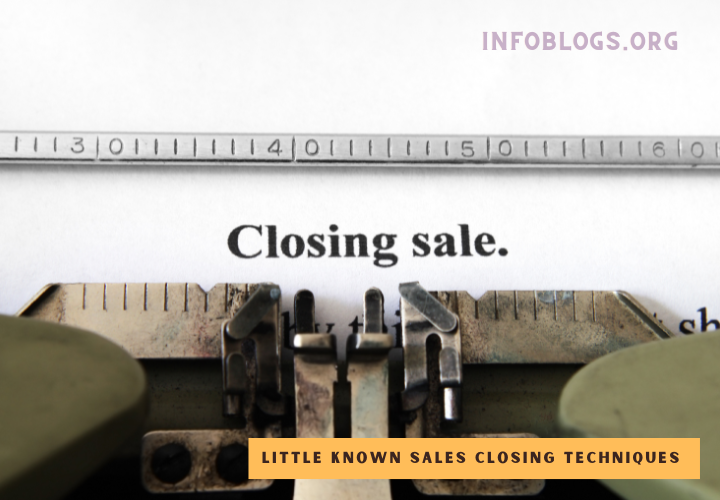Are you looking for sales closing techniques that will help you close more deals? Look no further! This article provides an overview of some little known sales closing techniques, which can be used to increase your conversion rate.
If you want to succeed in sales, it is essential to learn effective sales closing techniques. These techniques can help convince customers that a product or service is the right choice for them. It is also important to understand how different types of customers respond to certain approaches and strategies. By understanding these dynamics, salespeople can better tailor their messages for maximum effectiveness.
The strategies discussed here include highlighting the benefits of making the purchase, emphasizing urgency and scarcity, creating comparison statements and offering discounts or special deals if customers buy now. Each strategy has its place in a successful sales process and should be utilized accordingly.
Benefits of Closing Techniques
Closing a sale is one of the most important steps in the sales process. It’s essential to know and understand different closing techniques in order to successfully close a deal and make it beneficial for both parties. This article will look at some lesser known closing techniques that are sure to help you close more sales and increase your success rate.
The first technique is called ‘the assumptive close’. This method works by having you assume that the customer has already agreed to buy from you. You can then move on from there with other details such as payment plans, shipping dates, etc., giving the customer comfort that their decision is already made. The second technique is ‘the alternative choice close’ which gives customers two buying options where either way they are still buying from you.
The assumptive close
The assumptive close is one of the most effective and least known sales closing techniques available. It involves making an assumption that a customer has already made a decision to purchase and can be used to subtly influence them towards actually taking the plunge. The assumptive close leaves customers with the feeling that they are in control, eliminating any potential feelings of pressure or being pushed into a sale.
This tool is particularly helpful when selling services or propositions which require more thought and consideration than standard items. By using this technique, salespeople can move away from relying on facts alone and give customers a sense that their own opinion is important too by allowing them to confirm assumptions they had already made. This approach ensures that customers feel empowered when deciding whether or not to make their purchase, leaving them feeling happier overall with their decision-making process.
The Alternative Choice Close
Sales closing techniques are essential for any business success. It’s the final step in a sales process that helps to bring home the deal and make sure your customer is satisfied with their purchase. The conventional closing techniques are well known, but there is also an alternative choice close that is not as widely used but can be just as effective.
The alternative choice close involves providing two distinct options to the customer and asking them which one they would prefer. This technique allows you to present information in a way that makes it easier for them to choose; giving them two options instead of making them commit right away with only one option on the table. It can ease the decision-making process and help increase conversion rates. Additionally, this tactic encourages customers to weigh both choices carefully, creating more meaningful conversations between you and your customer.
Objections & Overcoming Them
Sales closing techniques are essential for any successful salesperson, yet many are unaware of the subtle ways to overcome objections in order to close a sale. When discussing a product or service with potential customers, it's normal for them to raise questions and express doubts about whether it is the right choice for them. The key is to be prepared with answers that will address their concerns and motivate them to make a purchase.
When facing objections, the best approach is to stay calm and listen closely. Look for underlying reasons why they may be hesitating and try not to take their concerns personally. Once you have identified the issue at hand, explain why your product or service can help solve their problem and emphasize its benefits. Follow up by asking open-ended questions that will encourage further discussion on how your offering could benefit them specifically.
Soft Close Strategies
Soft Close Strategies are an important part of any sales process. The ability to close a sale, or even just move the sale along, can make all the difference in an organization's success. With that said, there are certain strategies that can be used to help improve your closing rate and encourage customers to take action. Here are some of the most effective soft close techniques that you should consider when trying to seal the deal:
First, it is important to engage with your customer by asking questions related to their needs and interests. This will give you insight into what they want and enable you to use language that speaks directly to them. Secondly, establish a sense of urgency by mentioning limited time offers or other incentives for acting quickly. Doing so can help motivate customers who may otherwise be hesitant about pulling out their wallets. Thirdly, try using storytelling as a tool for persuasion.
Hard Close Tactics
When it comes to closing sales, hard close techniques are often seen as the most successful strategy for salespeople. Hard close tactics involve using persuasive strategies and a certain degree of assertiveness in order to encourage customers to make their purchase. While some may view these tactics as too aggressive, when used correctly, they can be an effective way of sealing the deal.
Hard closes usually involve actively responding to customer objections, working out compromises and presenting offers that help alleviate buyers' fears. Some common examples include making a special offer or discount that's only available if purchased on the spot; focusing on cost savings or benefits that the customer will enjoy by purchasing now; and highlighting time-sensitive offers like limited availability or one-day discounts. By presenting attractive incentives, salespeople can increase their chances of converting customers into paying customers quickly and easily.
Negotiation Strategies
Negotiation Strategies are essential in a sales closing environment. Knowing how to talk to customers and drive them towards the product or service that you are selling is key for success. In order to be successful at negotiations, business owners must understand the dynamics at play and be willing to use different strategies to clinch the deal.
One of the most important negotiation strategies is being able to identify customer’s motivation and needs when they come into contact with your offering. If business owners can quickly determine what drives their customers, they can then craft specific messages that address those needs. Furthermore, it’s also important not just to focus on price but instead focus on value as well – emphasizing all the features that buyers could get if they purchase from you such as discounts or free shipping.
Conclusion: Closing the Sale
The conclusion of any successful sale is the point at which both parties are satisfied with the outcome. As a salesperson, it's important to know effective closing techniques to ensure that your customer leaves with a sense of satisfaction and accomplishment.
In this article, we've discussed some lesser-known sales closing techniques that can be used to effectively close a sale. First, it's essential to understand the needs and preferences of your customer in order to tailor your sales pitch towards their unique situation. Additionally, you should consider using incentive-based strategies in order to encourage them to take action on their purchase decision. Finally, you must employ active listening skills and pay attention for verbal or nonverbal cues that will inform you when it’s time to transition into asking for the sale. By utilizing these little known tactics and strategies, you'll be sure increase your success rate when closing deals!


